A Profile of Del Tin Armi Antiche
An article by Björn Hellqvist
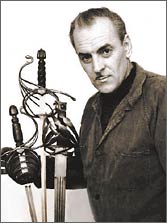
Silvano Del Tin in 1967
|
In Italy, in the foothills of the Alps some 60 miles north of Venice, lies the town of Maniago. This has been a center of cutlery manufacture for 400 years, and since 1966 also a prime source for sword replicas. Del Tin Armi Antiche was started by Silvano Del Tin, father of Fulvio Del Tin, almost by accident. He was a switchblade maker, who in 1965 made a few swords and halberds for himself. These came to be on display at an exhibition in Florence, where they became a success. This made him decide to change his production to replicas of antique weapons the year after, assisted by his older son Flavio. The
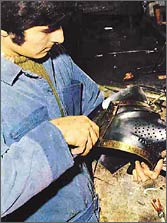
Fulvio Del Tin in 1972
|
other two sons joined a few years later; Fulvio in 1970, Maurizio in 1973. Silvano Del Tin passed away in 1975, leaving the company to his sons. In 1977, Del Tin Armi Antiche relocated to the current workshop. For many years, Fulvio and his two brothers worked there, but in 1978 Flavio left to become an antiques dealer, and Maurizio left in 1992. Today it is operated by Fulvio alone, assisted by several skilled craftsmen working in their own workshops in Maniago.
When asked if it was an obvious choice to take over the business, Fulvio tells me that he has always had a passion for old weapons. "I remember that in the 60s, my father and I went to visit the Doge Palace Armoury in Venice and I was very impressed by it". As a boy, he spent much of his spare time in his father's workshop, where he made toys, belts and other things from various metals, wood and leather. This formed his basic training, and one day he was to make his first weapon, something that he has fond memories of: "I made my first dagger under the supervision of my father when I was 11, and I still have it in my showroom". Today, Fulvio makes all the weapons, apart from the stages in production made by his assistants. He keeps a constant eye on the manufacturing process to ensure the quality. To make the blades, Del Tin uses the method of stock-removal, where lengths of spring steel are ground to the right shape. This is a way of making the swords affordable, as hand-forged blades require a lot more work. The delicate task of tempering the blades is something he does himself. The Krupp CK55 steel used for so many years was dropped some ten years ago in favour of the 50CrV4 steel, which has proved to be an improvement much appreciated in re-enactment circles.

Fulvio Del Tin in the showroom
|
Over the years, many thousands of swords and daggers have been shipped to customers all over the world. But Del Tin has made much more, like halberds, axes, warhammers, maces, spears, crossbows, helmets, shields and suits of armour. While Del Tin has to become synonymous with replicas of European swords, it has not always been so. During the early 70s, there were katanas and tantos to be found in the Del Tin range. However, they were discontinued in 1976 in favour of the European weapons. For the
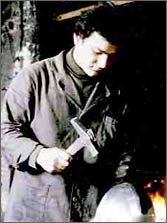
Maurizio Del Tin in 1976
|
last few years, the demand for swords and daggers has been so great that Fulvio has concentrated on bladed weapons, dropping the production of pole-arms, spears, maces, warhammers and axes. There is a constant drive to add new swords to the range, and as an effect, some models are discontinued. This is the result of Fulvio's policy to improve the aesthetic and functional aspects. Still, there are a few swords and daggers that have become classics, having been around since 1980. Among these are a couple of one-handed swords (Models #2144 and #2157), a Schiavonesca sword (#2152), and a main gauche (parrying dagger; #2172).
As the weapons from Del Tin combine both looks and function, they've become a common sight in movies with swordplay. Big Hollywood productions like The Three Musketeers (1993), Robin Hood: Prince of Thieves and Braveheart have used swords from Del Tin. In the case of Braveheart, the blade of the very sword Mel Gibson used (to devastating effect!) came from the Maniago workshop. Del Tin has also produced arms and armour for several exhibitions in museums and castles, many of them one-off pieces which were a nice change of pace.
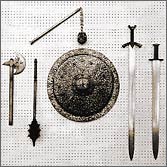
Humble beginnings:
The first arms, 1965
|

A suit of 1390s armour
made in 2001
|
One of the hallmarks of Del Tin's weapons is the no-nonsense style. Compared to the gaudy decorative swords from Spanish manufacturers, the Del Tin's look plain. The more authentic look is an effect of the close attention to detail and the thorough research made. When asked what he looks for when deciding on a new model, Fulvio responds: "All the pieces I make are a selection of the many swords I find in museums and private collections. I sometimes visit museums such as the Doge Palace Armoury in Venice and the Stibbert Museum in Florence, among others. I spend a lot of time to look at the pieces in detail. The choice of a new piece is determined both by my taste and by requests from my customers." When asked if he uses books on swords for inspiration, his answer is simple: "Printed sources themselves are not enough; knowledge is given only by seeing the pieces directly. But of course my books supply some good help." The cooperation with museums has led some of them to become customers of Del Tin, one of them the The Royal Armouries, Leeds.
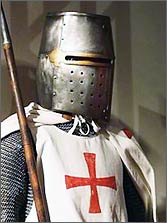
A Templar knight from
an exhibition in 2002
|
Since the mid-90s, Fulvio has come to rely on his computer in the everyday running of his business. The ability to email his customers has made the contact more efficient. Like so many others, Fulvio has discovered the potential of the Internet. His Web site features an online catalogue, as well as a history of the firm and some other articles.

A Holbein dagger and ornate
scabbard made by Fulvio Del Tin
as a hobby project
|
If anyone thought that just any request will be met, well, be prepared to be in for a disappointment. Fulvio will not change his way of how to choose a new model. "I do not like to make fantasy swords", he says, preferring pieces copied from originals or inspired by the iconography of the time. As for custom swords, Fulvio prefers to make modifications on existing models. While the swords from Del Tin are, just like the originals, quite serviceable as weapons, there's one thing Fulvio won't do. As he says on the issue of live steel weapons: "Safety comes first. I do not accept to make sharpened blades or stilettos, as they may be dangerous. I do not want my pieces to be considered as real weapons to be used against other people, but merely pieces of art and for re-enactment fighting." Still, it's through use that the swords have improved. The feedback from re-enactment groups has proved to be an invaluable source for improving the performance. It has resulted in the change of steel quality, as well as the possibility to get a somewhat thicker edge.
Fulvio confesses to be no swordsman himself: "I do not practice medieval sword fighting, but I can say that I do have a special feel for swords when I handle them." That, and the experience from over 35 years in the business, has made the name "Del Tin" come to stand for affordable, tough swords that appeal to both collector and swordsman alike. The swords have been copied but seldom surpassed. Not bad for a company that started out with a few swords and halberds back in the mid-60s...
About the Author
Björn Hellqvist is a Swedish optometrist with an interest in historical European swords.
Author's Note
This article is based on an interview made in 1998, with updates made in 2003.
Acknowledgements
Photographs courtesy of Del Tin Armi Antiche
|
|

